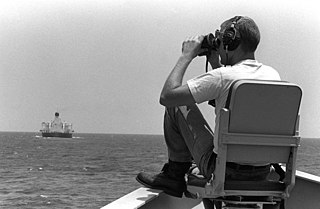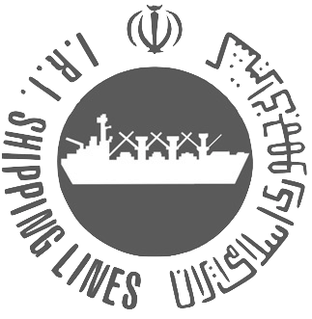
The Tuvalu Ship Registry is the body appointed by the government of Tuvalu to register ships under the Tuvalu flag.

The Tuvalu Ship Registry is the body appointed by the government of Tuvalu to register ships under the Tuvalu flag.
The ship registry was launched in 2004 and is located in Singapore and operated by Tuvalu Ship Registry Pte Ltd. The ship registry is managed on behalf of the Tuvalu Government by Sovereign Ventures (SV) Pte Ltd. [1] [2]
The responsibilities of the Registry include: [3]
Total: 245 [4]
By type: bulk carrier 18, container ship 2, general cargo 36, oil tanker 27, other 162 (2017) [4]
Tuvalu entered the international spotlight in 2012 when ships that were sailing under the flag of Iran were registered in the Tuvalu Ship Registry. In response to the European boycott of Iranian oil exports over Iran's nuclear policy, a number of oil tankers changed to Tuvalu flags. [5] According to Radio Australia, this could lead to unforeseen consequences for the small nation. [6] The Iranian vessels were accepted by Tuvalu Ship Registry as they were earlier flagged under Malta and Cyprus flags which were well-known reputable flags. However, upon further understanding that the vessels were actually sanctioned by the US and EU, the Government of Tuvalu took swift action to instruct the Tuvalu Ship Registry to de-register all possible Iranian-linked vessels on 16 August 2012. The Iranian-linked vessels were de-registered by 21 September 2012 and press releases of the actions taken by the Tuvalu Ship Registry are posted on its website. [7] [8] [9] [10] [11] [12] The Iranian vessels were later rumored to have gone to other flags such as Tanzania, Mongolia and others.
This article lists transport in the Cook Islands.

The Strait of Hormuz is a strait between the Persian Gulf and the Gulf of Oman. It provides the only sea passage from the Persian Gulf to the open ocean and is one of the world's most strategically important choke points. On the north coast lies Iran, and on the south coast lies the Musandam peninsula, shared by the United Arab Emirates and Musandam Governorate, an exclave of Oman. The strait is about 90 nautical miles (167 km) long, with a width varying from about 52 nmi (96 km) to 21 nmi (39 km).

The national flag of Sierra Leone is a tricolour consisting of three horizontal green, white and blue bands. It was adopted in 1961, Sierra Leone's independence year, to replace the British Blue Ensign defaced with the arms of the Crown Colony of Sierra Leone.

The Exxon Valdez was an oil tanker that gained notoriety after running aground in Prince William Sound, spilling its cargo of crude oil into the sea. On 24 March 1989, while owned by the former Exxon Shipping Company, captained by Joseph Hazelwood and First Mate James Kunkel, and bound for Long Beach, California, the vessel ran aground on the Bligh Reef, resulting in the second largest oil spill in United States history. The size of the spill is estimated to have been 40,900 to 120,000 m3. In 1989, the Exxon Valdez oil spill was listed as the 54th-largest spill in history.

Flag of convenience (FOC) is a business practice whereby a ship's owners register a merchant ship in a ship register of a country other than that of the ship's owners, and the ship flies the civil ensign of that country, called the flag state. The term is often used pejoratively, and although common, the practice is sometimes regarded as contentious.

USS McFaul (DDG-74) is an Arleigh Burke-class destroyer in the United States Navy. She is named for U.S. Navy SEAL Chief Petty Officer Donald L. McFaul. This ship is the 24th destroyer of her class. USS McFaul was the 11th ship of this class to be built at Ingalls Shipbuilding in Pascagoula, Mississippi, and construction began on 26 January 1996. She was launched on 18 January 1997 and was christened on 12 April 1997. On 25 April 1998 she had her commissioning ceremony at the Garden City Terminal in Savannah, Georgia. As of July 2020 the ship is part of Destroyer Squadron 26 based out of Naval Station Norfolk.

Operation Earnest Will was the American military protection of Kuwaiti-owned tankers from Iranian attacks in 1987 and 1988, three years into the Tanker War phase of the Iran–Iraq War. It was the largest naval convoy operation since World War II.

Iran–United Kingdom relations are the bilateral relations between the United Kingdom and Iran. Iran, which was called Persia by the West before 1935, has had political relations with England since the late Ilkhanate period when King Edward I of England sent Geoffrey of Langley to the Ilkhanid court to seek an alliance.

The Islamic Republic of Iran Shipping Line Group, commonly known by its business name IRISL Group, is a shipping line based in and owned by Iran. Its fleet comprises 115 ocean-going vessels with a total capacity of 3.3 million tons deadweight (DWT), with 87 being ocean-going vessels owned by IRISL and the remaining 28 ships being owned under the flags of subsidiary companies, including Khazar Shipping, Valfajr and Iran-India Shipping. They are manned by 6,000 personnel who work under the Iranian flag in the Caspian Sea, Persian Gulf, international waters and various ports of the world.

An oil tanker, also known as a petroleum tanker, is a ship designed for the bulk transport of oil or its products. There are two basic types of oil tankers: crude tankers and product tankers. Crude tankers move large quantities of unrefined crude oil from its point of extraction to refineries. Product tankers, generally much smaller, are designed to move refined products from refineries to points near consuming markets.

MV Sea Isle City, ex-Umm al Maradem, was a Kuwait Oil Company oil tanker that reflagged during Operation Earnest Will. The ship was completed in 1981 by Mitsubishi Heavy Industries, Japan, as hull number 1867, for the Kuwait Oil Tanker Company.

The history of the oil tanker is part of the evolution of the technology of oil transportation alongside the oil industry.

British Tanker Company Limited was the maritime transport arm of the Anglo-Persian Oil Company, the forerunner of BP. Formed in 1915 with an initial fleet of seven oil tankers, the British Tanker Company became the BP Tanker Company in 1955.
British Bombardier was an 8,202 GRT tanker which was built in 1942 as Empire Fusilier and completed as Empire Bombardier. She was built for the Ministry of War Transport (MoWT); postwar, she was sold to British Tanker Co Ltd, serving until she was scrapped in 1959.
Sanchi was the final name of a 2008-built Panamanian-flagged Suezmax crude oil tanker that was operated by the National Iranian Tanker Company (NITC) under a variety of ship registries and names. On January 6, 2018, it collided with a cargo ship, CF Crystal in the East China Sea and caught fire with 32 deaths or missing and 130,000 tons of condensate oil spill. After drifting for eight days and several explosions Sanchi sank, causing extensive pollution.

On 12 May 2019, four commercial ships were damaged off Fujairah's coast in the Gulf of Oman. The ships included two Saudi Arabian registered oil tankers, a Norwegian registered oil tanker, and an Emirati registered bunkering ship. The ships were anchored on the United Arab Emirates territorial waters for bunkering in Port of Fujairah. The Ministry of Foreign Affairs of the United Arab Emirates reported that the ships had been subject to a "sabotage attack". The United Arab Emirates launched a joint investigation probe with United States and France. The initial investigation assessment determined that 5-to-10-foot holes near or below all the ships' waterlines were probably caused by explosive charges.

On 13 June 2019, two oil tankers were attacked near the Strait of Hormuz while they transited the Gulf of Oman. The Kokuka Courageous, flagged in Panama and operated by a company based in Japan, and Front Altair, flagged in Marshall Islands and operated by a company based in Norway, were attacked, allegedly with limpet mines or flying objects, sustaining fire damage. American and Iranian military personnel responded and rescued crew members. The attacks took place a month after the similar May 2019 Gulf of Oman incident and on the same day, Iranian Supreme Leader Iran Ali Khamenei met with Japanese Prime Minister Shinzō Abe in Iran. Abe was acting as an intermediary between US President Donald Trump and Khamenei.
Iran's Islamic Revolutionary Guard Corps stated on 25 October 2021 that they had thwarted an attempt by the United States to capture and detain a tanker carrying Iranian oil in the gulf of Oman by carrying out a heliborne operation and directing the ship back to Iran's territorial waters. The Pentagon rejected the Iranian statement and said that Iranian forces had seized a Vietnamese-flagged oil tanker in October.
On 19 April 2022, the Iranian-flagged tanker Lana, with 19 Russian crew members on board, was seized by Greek authorities near the southern island of Evia; this sparked an international incident. Greek authorities had connected Russian sanctions imposed by the European Union after the Russian invasion of Ukraine in February to the tanker seizure in Greece.
As part of the sanctions imposed on the Russian Federation as a result of the Russo-Ukrainian War, on September 2, 2022, finance ministers of the G7 group of nations agreed to cap the price of Russian oil and petroleum products in an effort intended to reduce Russia's ability to finance its war on Ukraine while at the same time hoping to curb further increases to the 2021–2023 inflation surge.